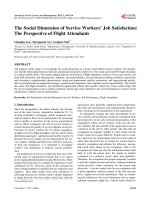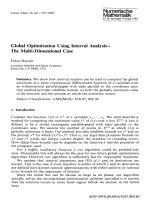E-business – the strategic dimension
Bạn đang xem bản rút gọn của tài liệu. Xem và tải ngay bản đầy đủ của tài liệu tại đây (95.11 KB, 8 trang )
ONE E
-
BUSINESS
–
THE STRATEGIC DIMENSION
7
ONE
E-business – the strategic
dimension
In periods of transition such as the one we have
been going through, it often appears as if there
are new rules of competition. But as market forces
play out, as they are now, the old rules regain
their currency. The creation of true economic
value once again becomes the final arbiter of
business success.
MICHAEL PORTER, WRITING IN HARVARD BUSINESS REVIEW, MARCH 2001
Many have argued that the introduction of the internet into business
practices renders the old rules of strategy and competitive advan-
tage obsolete. According to Harvard Business School professor
Michael Porter, the opposite is true: ‘The only way [for companies to
be more profitable than the average performer] is by achieving a
sustainable competitive edge – by operating at a lower cost, by
commanding a premium price, or by doing both.’
The internet tends to weaken industry profitability without provid-
ing proprietary operational advantages, it is therefore more important
than ever for companies to distinguish themselves through strategy.
The winners will be those that view the internet as a complement to,
not a cannibal of, traditional ways of competing.
GURUS ON E
-
BUSINESS
8
Many of the early internet pioneers, both the newly minted dot.coms
and those well-established companies seeking an online presence,
have competed in ways that violate nearly every principle in the strat-
egy rule-book. As Porter puts it: ‘Rather than focus on profits, they
have chased customers indiscriminately through discounting, channel
incentives, and advertising. Rather than concentrate on delivering
value that earns an attractive price from customers, they have
pursued indirect revenues such as advertising and click-through fees.
Rather than make trade-offs they have rushed to offer every conceiv-
able product or service’.
The good news is that it did not have to be this way – these were bad
strategic choices but they were not the only options available. And
these choices had little to do with the inherent business potential of
the internet.
In fact, when it comes to reinforcing a distinctive strategy, Porter main-
tains that the internet provides a better technological platform than
any previous generation of IT.
For most existing industries and established companies, the inter-
net rarely cancels out important sources of competitive advantage;
if anything, it is more likely to increase the value of those sources.
But over time, says Porter, the internet itself will be neutralized as a
source of advantage as all companies embrace its technology.
At which point, we may well see a return to the good old days when
competitive advantages will once again explicitly derive from tradi-
tional strengths such as unique products, proprietary content and
distinctive physical activities. Internet technology may be able to fortify
those advantages, but it is unlikely to supplant them.
The message, then, is clear. Gaining competitive advantage in the post-
internet business world does not require a radically new approach
to business; and it certainly does not require the abandonment of classic
economic principles that can still offer strategic value in a market place
that depends on cutting-edge information technology
ONE E
-
BUSINESS
–
THE STRATEGIC DIMENSION
9
No, gaining competitive advantage in the early years of the 21st century
is still reliant on applying proven principles of effective strategy.
Sources of strategic advantage rest where they always have – in cost
competitiveness, product differentiation, ease of entering and exiting
markets, and so on. The significance of the internet is in how it can
impact on these traditional battlegrounds. Here are some examples:
The internet offers huge scope for
cost-cutting
General Electric now does more business on its own private online
market place than all the public B2B exchanges put together. Siemens
hopes to cut its annual costs in the medium term by 3-5%. And there
is room for more. One estimate quoted recently in The Economist puts
the cost of e-procurement per order placed for routine office
purchases at only 10% of physical procurement costs. Low-cost airlines
like Ryanair have slashed their costs by using the internet to dispense
with the need for tickets and to cut out travel agents. To date, only a
minority of companies have got to grips with the cost-saving poten-
tial of the net. A 2001 survey by the National Association of
Manufacturers found that only around 30% of American manufac-
turers were using the internet to sell or procure products or services.
The hare, the tortoise and the internet
Another myth, disputed by Michael Porter et al., is that the internet
offers huge ‘first-mover’ advantages. However, companies that took
to the internet relatively late and with some caution don’t necessar-
ily seem to have suffered: if anything, they seem to have gained from
being able to avoid the mistakes and the huge spending of the pioneers.
The fate of many internet retailers has shown that established
GURUS ON E
-
BUSINESS
10
companies can catch up relatively easily. The contrast between
Britain’s biggest supermarket chain, Tesco, selling its e-buying
system to America’s Safeway and the collapse of Webvan, the most
ambitious and best-capitalized online grocery chain, is instructive.
There is also a strong suggestion that the internet could well be lower-
ing, not raising barriers to entry.
Internet only companies carry less
organizational baggage
The big boys aren’t having it all their own way. The arrival of new,
internet-based firms that are more agile and innovative than the giants
is shaking up whole industries and business sectors. Without ques-
tion, the internet is helping to put some small agile newcomers on a
par with large corporations and letting them compete head on with
them for new business. Just as Microsoft came from virtually nowhere
to usurp the market of mighty IBM, so a few years later Netscape
appeared overnight and threatened to undermine the market (and
the size) of Microsoft. Who will be next? And where will they come
from?
He who pays the piper…
Another consequence of the growth of the internet as a business
medium, says Robert Baldock in his book The Last Days of the Giants?,
has been a shift in power from the seller to the buyer. According to
Baldock, ‘the convergence of computing, communications and
content in the shape of personal computers (PCs) hooked up over a
network to the internet has triggered a revolution in the way busi-
ness is conducted. Users of these technologies have 24 hour access
to almost everything, everywhere’.
ONE E
-
BUSINESS
–
THE STRATEGIC DIMENSION
11
The rise and fall of the middleman
Part of the paradox of the internet is that intermediaries are blessed
under one business model and cursed under another.
On the positive side, internet-based search agents make it possible
for these users to track down the cheapest products in seconds, and
new internet-based intermediaries (the so-called ‘Infomediaries’) have
created a new form of commerce whereby the buyer sets the price,
not the seller.
On the other hand, according to the ‘cursed’ theory, information tech-
nology puts producers directly in contact with their customers,
collapsing the distribution chain, wiping out all those who have made
their living by taking orders or breaking big lots into smaller lots. A
spooky technical term has been coined for this process: disinterme-
diation. ‘Middleman functions between consumers and producers are
being eliminated,’ the futurist Don Tapscott wrote in the influential
best-seller The Digital Economy. Patrick McGovern, chairman of Inter-
national Data Group, the world’s largest high tech publisher, is even
more dour. ‘The intermediary is doomed,’ he wrote in Forbes ASAP.
‘Technology strips him of effectiveness.’
Internet-based alliances
The internet and digital media open up new ways to create wealth.
Companies like Schwab, eBay, Cisco, MP3 and Linux have transformed
the rules of competition in their industries by making revolutionary
offerings to their customers. They did not achieve this alone: combin-
ing with like-minded partners with complementary skills was the key.
In their book Digital Capital, Tapscott, Ticcoll and Lowy call these inter-
net-based partnerships or alliances ‘business webs’, or ‘b-webs’ for
short. A b-web, according to the authors, is ‘a distinct system of suppli-
ers, distributors, commerce services providers, infrastructure providers
and customers that use the internet for their primary business









